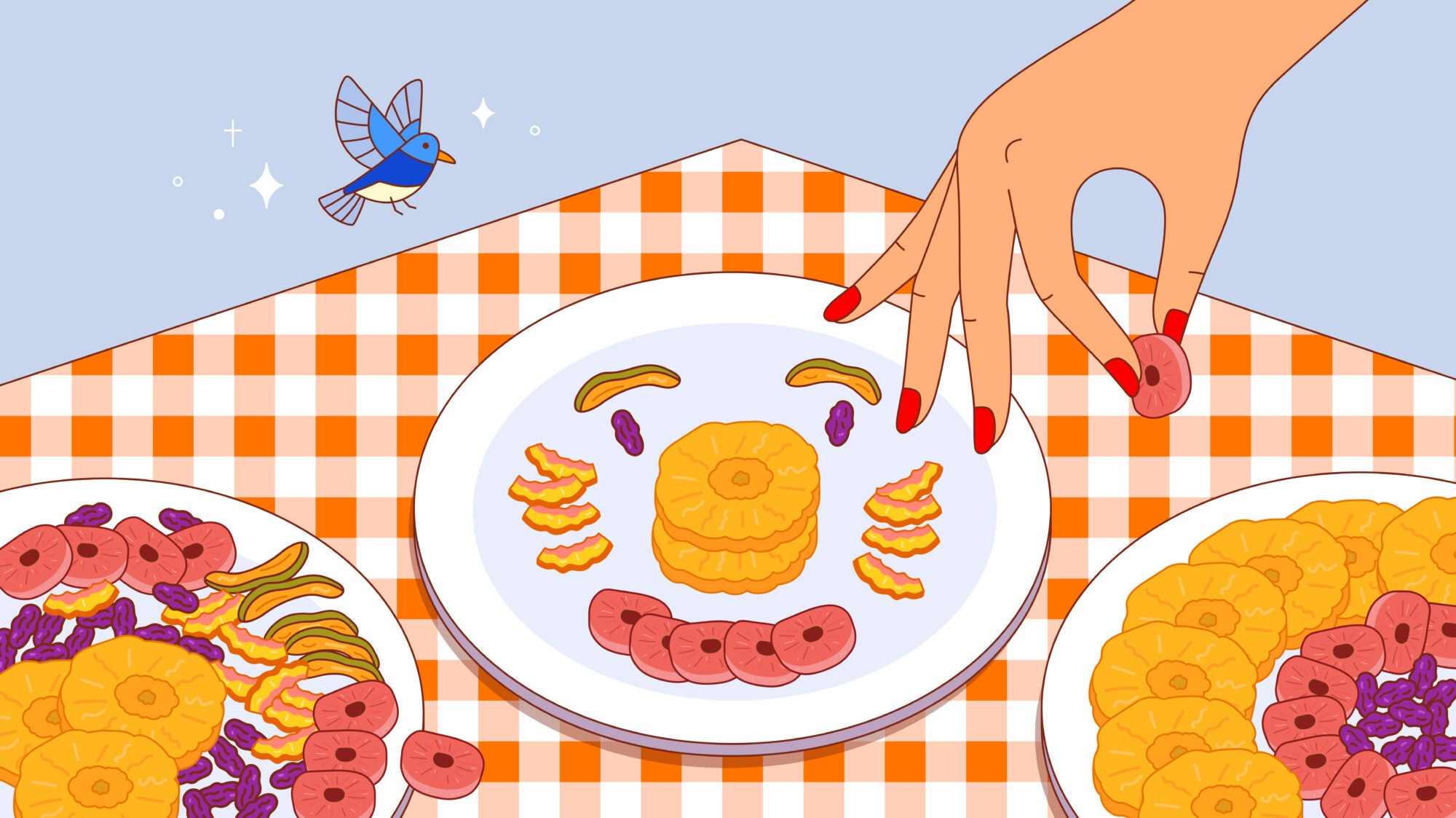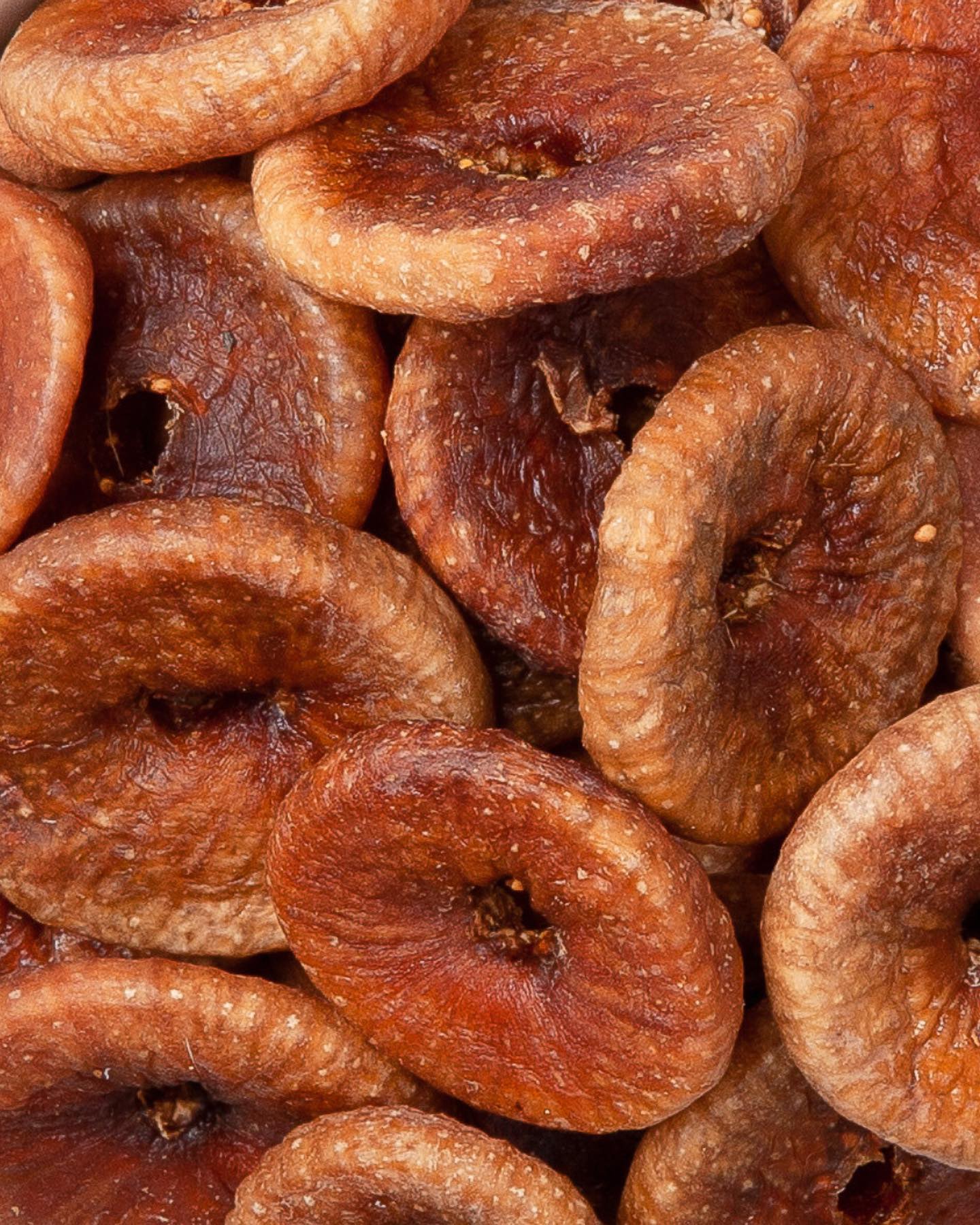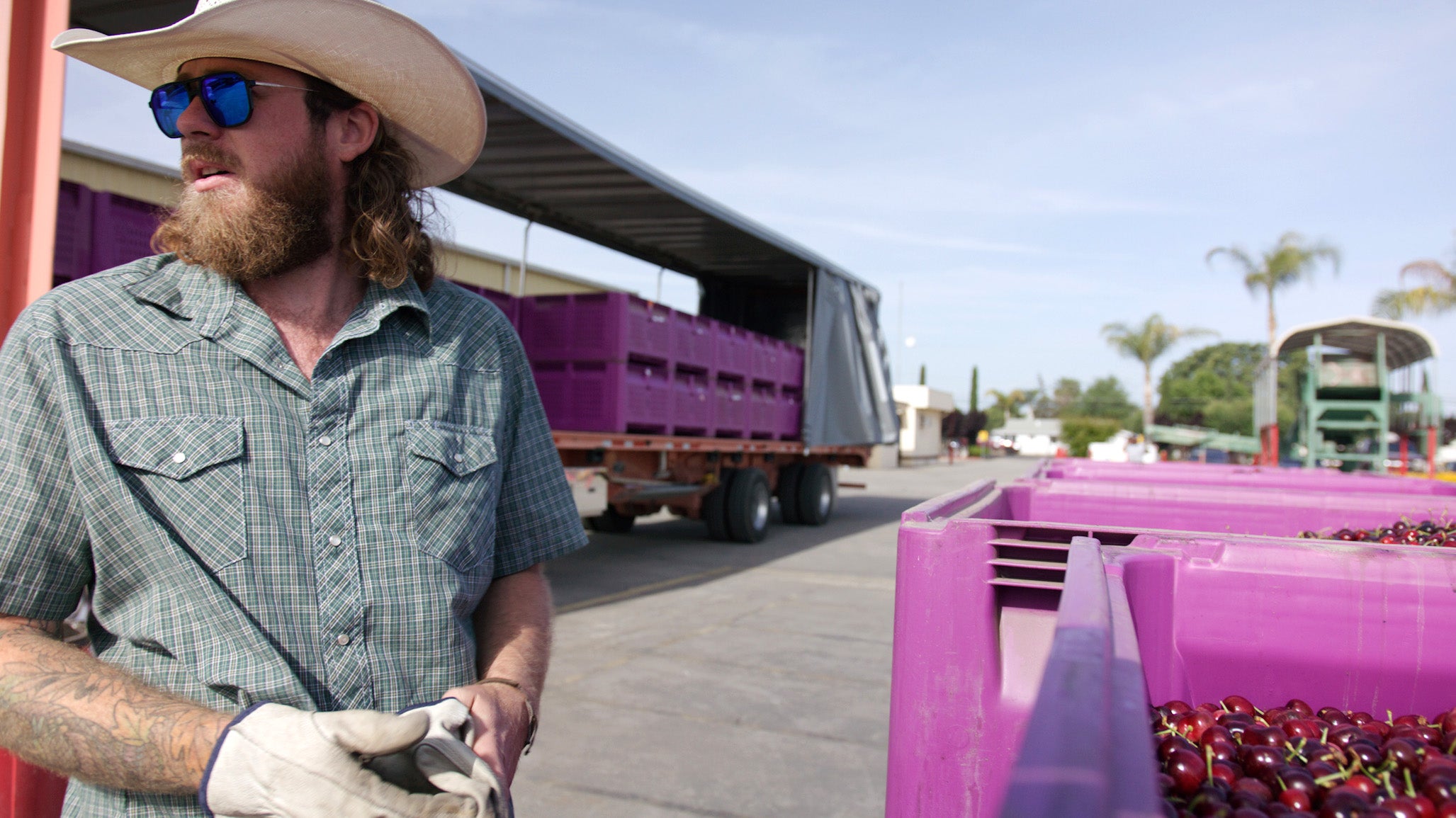
Three mission-driven brands are making the case with rescued peaches, heirloom raisins, and politically driven pineapples.
Dried fruit has a pretty unglamorous rap. Blame it on prunes, better known as a laxative than as a chewy, caramel plum. Or on the bonneted Sun-Maid girl (of the raisins box), an image of farming that one senses felt painfully idealized even when it debuted in the early 1900s. Those of us who grew up with the singing California Raisins—an experiment in anthropomorphizing dried fruit, the R&B group comprised of Cabernet-colored blobs with twig limbs had surprisingly wide cultural reach—may feel conflicted about the racialized caricature today. In the ensuing decades, candy-colored “fruit snacks” have largely replaced its much less-processed brethren. Save for bright spots like dried cranberries and mango strips (both of which are often heavily sweetened with added sugar) the dried fruit industry in the United States has become pretty, well, dry in recent years.
But there are many good reasons to eat dried fruit, and these have only seemed to proliferate. Harvests full of “ugly fruit” go to waste in America’s industrialized agriculture system. Without their water content, dried fruits are more concentrated in nutrients, containing up to 3.5 times the fiber, vitamins, and minerals of fresh fruit. Transporting and storing shelf-stable dried fruit is vastly less resource-intensive than for fresh fruit, so you’re moving and stocking more food for its weight than if it were fresh. Given that, you could leave a lighter carbon footprint by exploring new, exciting fruits from around the world when they’re in dried form. While you’re at it, you could help promote fair trade with small producers who are keeping sustainable, traditional processing methods and growing heritage varieties of fruits. Three mission-based brands are aiming to do all this with their dried fruit, transforming rescued peaches and nectarines from California orchards to squishy-sweet glory, bringing Afghan heirloom raisins and sun-dried figs to the United States, and helping Taiwanese pineapple farmers hit hard by a trade war with China sell their product.

Sun-dried figs from Ziba Foods
Ben Moore didn’t think much of the dried peaches and plums that his grandmother, a Swedish immigrant, made as snacks when he was growing up in central California. A fourth-generation farmer, Moore remembers that she would pick whatever fruit got missed after the crews had harvested, slice them, and dry them on the roof in redwood raisin trays.
“She tried drying cactus,” Moore recalls of her zeal for preserving. “Her motto was ‘waste not, want not.’”
But waste increasingly became a fact of farming life as Ben grew older, to the point where he was working as a driver, hauling fruit from farms in the area and dumping truckloads of slightly less than perfect peaches for them. “I was eating them like crazy, so I went back to her recipe book,” says Moore.
The dried fruit industry in the United States has become pretty, well, dry in recent years.
Two years later, in 2019, Moore launched the Ugly Company, selling pastel-colored pouches of dried peaches, nectarines, plums, cherries, mangoes, and kiwis that would otherwise go to waste. He estimates the company has prevented three million pounds of fruit from being wasted in 2023, and it’s on track to save twenty million pounds total by 2025. It hasn’t been easy to refashion fruit that was meant to be eaten fresh for dried production; one of the biggest challenges has been removing stickers. And unlike many other brands, the Ugly Co.’s dried fruit contains no added sugars or additives, like sulfur dioxide, which is often used to preserve the color of dried fruit but which some people may be sensitive to. That’s why Moore says their dried apricots are more tangy and not as bright orange as imported dried apricots from Turkey, which typically have sulfur dioxide.
Moore credits living abroad while he was in the army—in South America, Europe, and Africa—with giving him more perspective about food waste. According to the US Department of Agriculture, a staggering 30 to 40 percent of food produced in the United States is wasted. In other parts of the world, a less consolidated agriculture industry helps ensure that more second-best or third-best fruits are sold.

Ben Moore of Ugly Fruit.
There’s a rich tradition of making and eating dried fruits in other countries as well. While working as a trader in the freight market, Raffi Vartanian frequently traveled to Afghanistan and became enthralled by its culture—especially its food. If he was invited into someone’s home in Kabul, he was always greeted with an ornate tray holding various dried fruits and a pot of cardamom-scented green tea: fruits like white mulberries from the Hindu Kush mountains, flattened discs of whole, chewy figs, and long, juicy golden raisins. The latter are made from a green variety of grapes that are dried in the shade, so they hold more residual moisture and sugar than your average raisin. “You have this almost gummy-bear flavor and strawberry and honey—it’s so delicious,” says Vartanian of the golden raisins, which are called kishmish in Afghanistan.
The more Vartanian ate Afghanistan’s dried fruits and nuts, the more excited he became about bringing them to new customers—through an ethical supply chain, cutting out the various middlemen that typically eat away at producers’ profits. Together with Patrick Johnson, then working in development for Cummins, he launched Ziba Foods in 2018. The cofounders hope to shake up a sleepy snack food category with limited-run dried fruits like herati plums, heirloom Afghan almond varieties, and unique nuts like sweet apricot kernels, the likes of which neither had seen while growing up in the United States. In doing so, they hope to help lift Afghanistan’s dried fruit and nut industry, which was historically a strong global player but has floundered after decades of war. Like the Ugly Co.’s dried fruit, theirs are made without added sugars or preservatives. “A lot of people don’t like raisins, and nine times out of ten, we get a convert,” says Vartanian.
Farmers are particularly vulnerable to the whims of global trade, as you can’t just halt production on fields of ripening fruit. That was the crisis in 2021 for Taiwanese pineapple farmers when China imposed a politically motivated ban on Taiwanese pineapple imports, leaving an industry dependent on that market in the lurch. As the Taiwanese government urged the public to buy up the excess, eating pineapples became an act of national pride. But for Taiwanese people living abroad?
“We wanted to support the farmers, but there’s no way for us to bring the fresh fruit over [to the United States] despite lots of people wanting to buy it,” says Lillian Lin, co-owner of Yun Hai, a Taiwanese specialty food and kitchenware importer based in New York.
The brand had already been hoping to sell Taiwanese dried fruit. Grown in the tropical sun, fresh fruit is flavorful and well-loved on the island; according to Yun Hai co-owner Lisa Cheng Smith, people there just have higher standards when it comes to dried fruit as well. On travels back and forth from her home in New York, Cheng Smith observed other tourists stuffing their suitcases with Taiwanese dried fruits as souvenirs: “I was like, ‘Oh, Japan is onto Taiwanese dried fruit, and the United States is just not there yet.”’
Lin, who was in Taiwan at the time, connected small fruit farmers with a regional dried fruit producer, and Yun Hai launched a Kickstarter campaign to start selling dried Taiwanese Golden Diamond pineapples, Irwin mangoes, and Pearl guavas in dried form. It was funded by almost ten times its $12,000 goal. Yun Hai continues to sell iconic Taiwanese dried fruit, including wax apples and green mangoes—the latter made from a Taiwanese variety of mango that is harvested underripe, because it’s pruned from the trees earlier. “We call it nature’s sour gummy—it’s so zingy, [like] Sour Patch Kids,” says Cheng Smith.
The pruned green mangoes are traditionally eaten in Taiwan in a number of ways in addition to being dried; you could pickle them with sugar and salt and chop them up and eat them on shaved ice. “That’s old-school, like our grandparents’ era,” says Lin.
The green mangoes and guavas are the only dried fruits from Yun Hai that have added sugar and salt, and none have preservatives. Like the Ugly Co. and Ziba Foods, they’re sold in opaque, airtight plastic sachets to help keep them shelf-stable for months, though they’re best enjoyed as soon as possible.
“It’s harvested while it’s pretty ripe, so it has that very deep aroma you get when you eat the core of the mango, because the fruit is ripening from the inside out,” says Lin of the dried Irwin mango from Yun Hai. “So it’s juicy and tender, not all dry, papery, and sad.”